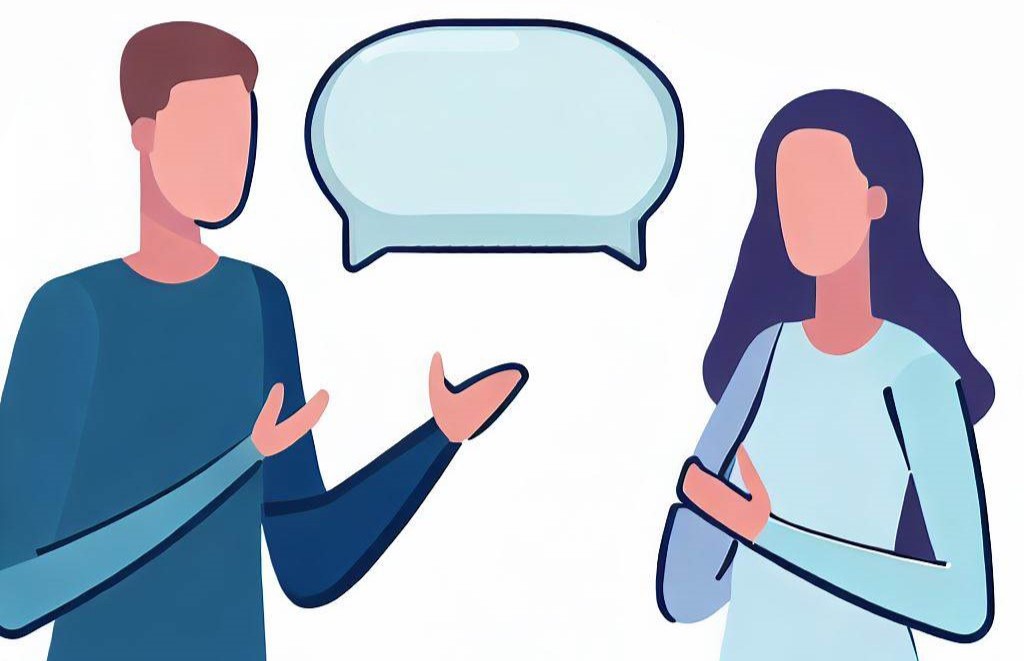Are you ever with someone where the conversation runs dry, and you have nothing to talk about? So you awkwardly repeat the same phrases, ask the same questions, and let any spark of interest fizzle out. It’s not because you don’t like talking to people, you just have no idea what to talk about.
Well, it’s actually a pretty common problem. The reason for being is because there’s no structure to your conversations. This is there the conversational threading technique really comes in handy.
Conversational threading is a technique which helps you direct a conversation and generate fuel for it. In another sense, this technique provides structure to your conversations which makes it much easier to keep a flow going.
So let’s break this technique down. Apply it to your conversations immediately and start practicing!
What are conversational threads?

Conversational threads are leads, otherwise, points of interest that you can pull out of an existing conversation. Think of them as keywords that someone mentions when they’re talking to you. You pick out the most interesting keywords, and ask questions about them.
Conversational threads allow you to elaborate on different topics and open up new conversational pathways. Think of it as a hyperlink in a blog article. If I mention the term ‘social calibration‘, and you follow that link, it’s going to lead you to another article which has many other hyperlinks leading to related articles.
This essentially creates a web of content, which is practically how conversations work. We use points of interest to transition the conversation into different subjects. By doing this, the conversation flows seamlessly, and there’s always something to talk about.
You can only talk about one topic for so long without branching away from it. Sooner or later, the topic runs dry. So naturally, we steer the conversation into other points of interest by using keywords that have already been put on the table.
Exercise: Identifying threads
In this little exercise, read the conversation below. Try to find as many conversational threads as you can. These threads should be mentioned words or phrases that you could ask questions about and change the direction of the conversation. After picking your threads, read the one’s I wrote down too, and compare.
Person A: Why are you changing careers?
Person B: Well, I’m just tired of my job in computer engineering. It’s just so repetitive and I feel like I’m not learning or growing, so every day is just the same thing. Luckily, I got an opportunity to do video editing for a friend of mine, so that’s what I’m going to do.
Person A: Sounds interesting, how did you get the opportunity to video edit?
Person B: Well, I know this person who has a startup, creating short form content and commercials. I have always loved the process of video editing, and I often create my own videos as an avocation. So, we talked about it, I showed him my content, and he said that’s what he’s looking for, and gave me a job on the spot.
- Tired of my job
- Computer engineering
- Not learning or growing
- New opportunity
- Video editing
- Friend
- Start up
- Short form content and commercials
- Love video editing
- Avocation
- my content
- Job on the spot
How to use conversational threads

Using conversational threads is to elaborate on any mentioned topic, and use that as a pathway to generate new points of interest. This is the most common way of generating material, without needing to think of random things to talk about.
Threads are always present in a conversation. We can interpret any point in a conversation as a thread. By picking up threads, you can use them immediately or come back to them. You should only follow a thread on a topic that you are interested in, otherwise, you’ll just be conversing as a chore, which is best to avoid.
Let’s look at an example:
Question: What have you been doing today?
Response: I caught up with some friends and went fishing. Otherwise, I’ve just been relaxing. You?
From this response, there are already a few points of interest that we can identify. This could be the topic of fishing, friends, or relaxing. Depending on what peaks your interest the most, you already have a few avenues that you can lead the conversation down.
So in this example, let’s hone in on the keyword ‘fishing’. From this one thread, some questions you could ask include:
- How long have you been fishing for?
- Where did you go fishing?
- Who did you go fishing with?
- How often do you go fishing?
- Why did you go fishing?
You can ask anything regarding the topic of fishing. This person would not have mentioned it if they weren’t willing to talk about it. If you also know a lot about the hobby, you can use this as a pivot point to engage in a more interesting conversation on mutual interests.
Exercise: Generating discussion
From the above exercise where you identified some threads from the dialog, pick out 5 of those threads and think of 3 questions you could ask about each of those threads. Below is my example.
A) Computer engineering
B) Not learning or growing
C) Video editing
D) Start up
E) My content
What is computer engineering?
What is the best thing about computer engineering?
Is computer engineering difficult?
Why do you feel learning and growing is important?
What are you wanting to learn?
How will growing benefit you?
What sort of video editing do you do?
Why do you like video editing?
Do you think video editing is difficult to learn?
How long has the startup been going for?
Is it a big group of people working on it?
How did they start their own business?
What content do you create?
Why are you creating content?
How much content have you created so far?
Creating conversational pathways

Someone telling you that they are stressed about work could go in many different directions. You are at an intersection. Breaking this down into three avenues, you could use the following responses.
A) Why are you stressed?
B) What do you do for work?
C) What do you need to do?
These are some branches for this thread, with each branch leading to more branches. Some of these branches will lead to weird and wacky topics, some will lead-off track, and some will die out. Let’s have a look at a conversation below, and see how it can branch down into different avenues of conversation.
Route A
Person A: Hi
Person B: Hey, how’s it going?
Person A: I’m good thanks, how are you?
Person B: I’m good too, where are you going?
Person A: I think I’m going to head down to the beach for a swim. Just finished work. What are you up to?
Person B: Sounds good, I might just catch up with some friends. Which beach are you heading to?
Person A: Probably Gunnamatta beach down the peninsula, it has great waves.
Person B: Sounds good. I know that beach, it’s far away though. Do you surf?
Person A: I don’t surf, I just love swimming there. What are you doing with your friends?
Person B: We catch up routinely to have some drinks. We might go out to dinner and have some drinks, not too sure yet.
Person A: That sounds good, what sort of places do you usually go for dinner? Any good spots around here?
Route B
Person A: Hi
Person B: Hey, how’s it going?
Person A: I’m good thanks, how are you?
Person B: I’m good too, where are you going?
Person A: I think I’m going to head down to the beach for a swim. Just finished work. What are you up to?
Person B: Sounds good, I might just catch up with some friends. What do you do for work?
Person A: I am an industrial designer, yourself?
Person B: I just finished my Masters of business management and I’m looking to start a business soon, how long have you been an industrial designer for?
Person A: I’ve been working in the industry for around four years, pretty recent to the job I’m working in now though.
Person B: Oh right cool, I think being an industrial designer would be an interesting job, why did you change your job?
Practical tips to make sure the conversation flow

With the framework down, now you know how to use the conversational threading technique to identify points of interest, generate more conversational material, and steer it in the direction you want.
Here we’re going to look at some tips to make the conversations flow better, and tune up this skill set so that you master it in no time.
Use good conversation openers
The opener is important, because the initial question sets the tone for the entire conversation. Many conversations are made or broken from the first encounter, so you want to make sure you get off to a good start.
When you open a conversation, you want to make sure you’re saying something that gives the other person something to talk about. If you just say ‘hey’, you’re really not leaving much to the imagination. If you say ‘wow, that’s a really unique jacket, where did you get it?’ there’s a lot more for them to talk about.
So start your conversations with a bang, and make sure you put your best foot forward.
Ask open-ended questions
Ask open-ended questions to provide the opportunity to speak and to engage the person more. If you ask yes/no questions, you’re going to get yes/no answers, and there’s not much space for you to steer the conversation there.
Ultimately, this is going to help you, because the more they speak, the more conversational threads are going to be available for you to use.
Plant threads
If you often respond with close-ended responses, you’re crippling your own chances to have a interesting conversation. It’s a two-way street. If someone asks you how your day was, don’t respond with a one word answer. Instead, briefly describe your day and finish with a question.
I suggest that you pay attention to your own responses and push yourself to speak a little more than you usually do. Make sure that you are generating enough material for the other person to use.
Active listening
You need to practice the skill of active listening, because you need to pay attention to what’s being said. If you’re not really paying attention, you’re going to miss all the conversational threads, and have nothing to talk about.
Therefore, be attentive to the conversation. Try to memorize some other keywords and phrases that have been used, to use as conversation fillers at a later point.
To further develop this skillset, check out the article below!
Storing threads
The lovely thing about conversational threads is that you can also store them. If someone drops a load of information, this is like hitting a gold mine because you will have plenty to talk about.
You can’t ask about everything at the same moment, so it’s good to remember points. Let the conversation flow naturally, but also try to remember some things that were mentioned earlier. This way you can come back without being abrupt or irrelevant.
Prioritize threads
When you’re having a conversation, some threads are going to be boring, other’s are going to be interesting. Always use the interesting threads first, because you want to keep the conversation rich and exciting. If someone mentions the weather and that they got in a car crash in the same sentence, it would be silly to talk about the weather.
Make the conversation dynamic
Nobody likes a bland conversation, so make sure it’s dynamic! You can make conversations more dynamic by exploring different conversational pathways and stimulating emotions. Talk about things that are funny, intriguing, sad, moving etc. Add some personality to the conversation and everyone’s going to have a much better experience.
Below is an article I suggest you read to better learn this dynamic, and to create rapport with people.
Go with the flow
Let the conversations flow naturally, and don’t change the conversation if there’s any resistance. By forcing the conversation to go in a particular direction, you’re disrupting the flow which can make the conversation abrupt, uncomfortable, and awkward.
Instead, just let it move naturally by following the path of least resistance. To learn more about how to do this, and to get your mind in the right headspace, I suggest you read the article below.

